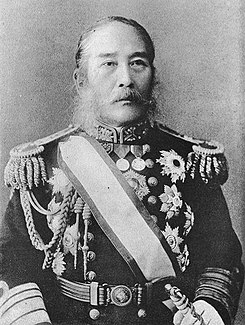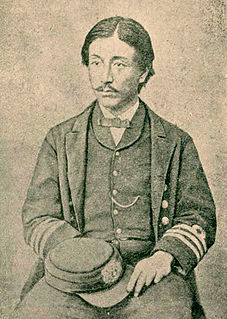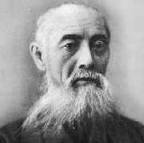 W
WEmperor Kōmei was the 121st Emperor of Japan, according to the traditional order of succession. Kōmei's reign spanned the years from 1846 through 1867, corresponding to the final years of the Edo period.
 W
WViscount Enomoto Takeaki was a Japanese samurai and admiral of the Tokugawa navy of Bakumatsu-period Japan, who remained faithful to the Tokugawa shogunate and fought against the new Meiji government until the end of the Boshin War. He later served in the Meiji government as one of the founders of the Imperial Japanese Navy.
 W
WIi Naosuke was daimyō of Hikone (1850–1860) and also Tairō of the Tokugawa shogunate, Japan, a position he held from April 23, 1858, until his death, assassinated in the Sakuradamon Incident on March 24, 1860. He is most famous for signing the Harris Treaty with the United States, granting access to ports for trade to American merchants and seamen and extraterritoriality to American citizens. He was also an enthusiastic and accomplished practitioner of the Japanese tea ceremony, in the Sekishūryū style, and his writings include at least two works on the tea ceremony.
 W
WKusaka Genzui , was a samurai of the Japanese domain of Chōshū who was active during the Bakumatsu period and a key proponent of the sonnō jōi movement.
 W
WBankichi Matsuoka was a Japanese naval officer in the Tokugawa Navy during the Boshin War, serving as Captain of the Japanese warship Banryū during the Battle of Hakodate.
 W
WMatsuura Takeshirō was a Japanese explorer, cartographer, writer, painter, priest, and antiquarian. During the late Edo period and Bakumatsu he journeyed six times to Ezo, including to Sakhalin and the Kuriles. In the early Meiji period he was an official in the Hokkaidō Development Commission. Instrumental in the naming of the island and many of its places, he is sometimes referred to as the "godparent of Hokkaidō".
 W
WNabeshima Naohiro or Nabeshima Chokudai was the 11th and final daimyō of Saga Domain in Hizen Province, Kyūshū, Japan. Before the Meiji Restoration, his name was Nabeshima Mochizuru and his honorary title was Hizen-no-Kami.
 W
WNegishi Shingorō 根岸信五郎 was a Samurai from Nagaoka Han in feudal Japan, was the 6th and last headmaster of the Shindō Munen-ryū from the feudal era of Japan, where this school of Japanese swordsmanship has its origin.
 W
WTakeda Kōunsai was a Japanese samurai from Mito Domain and councillor to Mito daimyō Tokugawa Nariaki in Bakumatsu period Japan. He became the leader of the Mito Rebellion and was executed by the Tokugawa shogunate with a large number of his followers shortly before the Meiji Restoration.
 W
WTokugawa Iemochi was the 14th shōgun of the Tokugawa shogunate of Japan, who held office from 1858 to 1866. During his reign there was much internal turmoil as a result of the "re-opening" of Japan to western nations. Iemochi's reign also saw a weakening of the shogunate.
 W
WPrince Tokugawa Yoshinobu was the 15th and last shōgun of the Tokugawa shogunate of Japan. He was part of a movement which aimed to reform the aging shogunate, but was ultimately unsuccessful. After resigning in late 1867, he went into retirement, and largely avoided the public eye for the rest of his life.
 W
WYoshida Shōin , commonly named Torajirō (寅次郎), was one of Japan's most distinguished intellectuals in the late years of the Tokugawa shogunate. He devoted himself to nurturing many ishin shishi who in turn made major contributions to the Meiji Restoration.